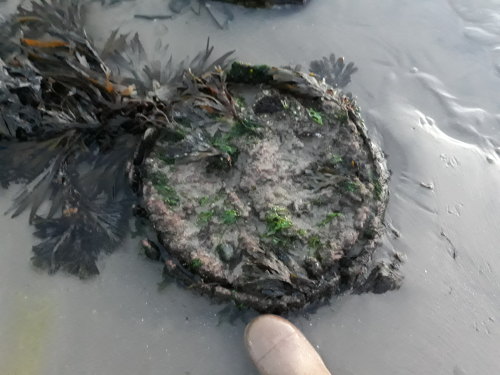
Image use policy
Our images can be used under a CC BY attribution licence (unless stated otherwise).
BARREL
Unique ID: MAS-O100234
Object type certainty: Certain
Workflow
status: Published ![]()
This find comprises of the remains of three to four wooden barrels, which were buried in the intertidal sandy substrate of a pleasure beach. The action of the tide revealed the barrels and it is unclear how much of the barrels remain. End of the staves, lengths of timber making the sides of the barrel, are visible and clearly degraded. In some cases these give the appearance of flaring outwards, implying that only the lower portion of the barrel remains. At least one barrel exhibits inwardly projecting staves, suggesting more than half of the barrel remains. There is some evidence for the remains of posts protruding from the barrels which otherwise give the appearance of having been filled with sand and stone.
The term cask is also used to describe barrels specifically intended for the storage of liquid, most commonly alcohol such as wine and beer. It has not been possible at this stage to ascertain the exact size and type of the barrels comprising this find, though it is estimated that they are of a small to medium size such as a Rundlet or Tierce. What the barrels were originally used for is not readily discernible, though it does appear that they have been repurposed for another function. The presence of posts within the barrels and their relative positions, laid out in a rough rectangle, suggests they used to accommodate foundation posts of a possible structure. This may have been a simple platform for bathers or anglers or something more complex such as a temporary jetty or pontoon. An image, submitted by the finder, dating to the 1850s shows structures in approximately the same position as the barrels, which may indicate the structure previously supported by the barrels. Alternatively they may relate someway to the practicing for the D-Day Landings in Normandy, which incorporated the beach and construction of landing pontoons. It has not been possible to firmly date this find from the available data, but given their condition and the preservation of the timber elements a more recent, post-medieval, date is tentatively suggested.
Notes:
Barrels have been in use since at least the time of the Roman Republic, with evidence suggesting their use from 350 BC or earlier (https://www.riverdrive.co/history-of-barrels/ accessed March 2020). Their suitability as water tight containers meant that, until the 20th century, they were essential for the transport and storage of food stuffs, water and alcohol. The whiskey distilling industry still uses traditional oak barrels extensively in the ageing process. The term barrel itself is a general term and there are many different types of barrel, determined by size, such as a firkin (c. 30 litres) and a tun (c. 954 litres).
Class:
Container
Sub class: Storage container. Food and liquid storage container
Evidence of reuse: Yes
Subsequent actions
Current location of find: Site
Chronology
Broad period: POST MEDIEVAL
Period from: ROMAN
Period to: MODERN
Dimensions and weight
Quantity: 4
Discovery dates
Date(s) of discovery: Thursday 27th September 2018
Personal details
Found by: This information is restricted for your login.
Recorded by: P T
Materials and construction
Primary material: Wood
Secondary material: Iron
Manufacture method: Hand made
Completeness: Incomplete
Spatial coordinates
4 Figure: NW6536
Four figure Latitude: 54.66413092
Four figure longitude: -5.64553486
1:25K map: NW6536
1:10K map: NW63NE
Display four figure position on What3Words
Unmasked grid reference accurate to a 1 metre square.
References cited
No references cited so far.
Similar objects

Find number: MAS-100012
Object type: LANDING CRAFT INFANTRY
Broadperiod: MODERN
This hulk is situated on the River Deben, just outside of Melton (Suffolk) and is estimated to measure 11.5 m in length and 3 m in width. The …
Workflow: Published![]()

Find number: MAS-O100031
Object type: TIMBER
Broadperiod: MODERN
Possible ships timber or part of other marine or land based structure. Truncated rounded timber with hole and evidence of mounting plate for f…
Workflow: Published![]()

Find number: MAS-D100180
Object type: CANNON
Broadperiod: POST MEDIEVAL
This item appears to be a small calibre black powder weapon, such as a swivel gun, commonly mounted on vessels throughout the age of sail as w…
Workflow: Published![]()




